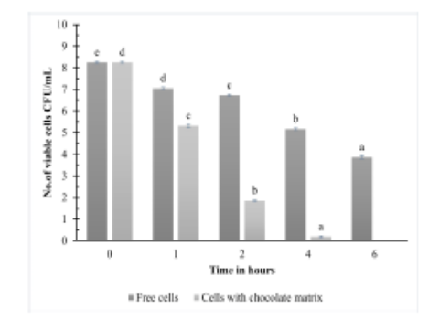


Indian Journal of Science and Technology
DOI: 10.17485/IJST/v16i38.1440
Year: 2023, Volume: 16, Issue: 38, Pages: 3283-3293
Original Article
Mausamy C Nandha1*, Rachana M Shukla2
1Department of Microbiology and Biotechnology, School of Sciences, Gujarat University, Ahmedabad, Gujarat, India
2Department of Microbiology, Gandhinagar Institute of Science, Gandhinagar University, Khatraj-Kalol Road, Moti bhoyan, Kalol, Gandhinagar, India
*Corresponding Author
Email: [email protected]
Received Date:12 June 2023, Accepted Date:08 September 2023, Published Date:17 October 2023
Objectives: To develop a probiotic dark chocolate by incorporating Lactococcus lactis sub sp. lactis, and evaluate its physicochemical and sensory characteristics, probiotic viability during storage, and behavior during in vitro gastrointestinal digestion. Methods: The probiotic dark chocolate was formulated through the inclusion of a strain of Lactococcus lactis subsp. lactis, sourced from the fermented Theobroma cacao L. forastero variety fruit harvested in Navsari, Gujarat, India. Subsequently, this probiotic dark chocolate underwent storage at both 4°C and 25°C for 90 days. In parallel, a control dark chocolate, devoid of probiotics, was subjected to testing. Analytical assessments encompassed parameters such as viscosity, pH, water activity, sensory evaluation, and probiotic viability evaluations under simulated gastric and pancreatic conditions. Findings: After 90 days of storage at 4°C, Lactococcus lactis subsp. lactis in probiotic dark chocolate declined from 8.25 to 6.42 log CFU/g (79.75% survival, p≤0.05), offering potential health benefits. pH shifted from 5.81 to 5.87 (p≤0.05), water activity increased (0.42 to 0.52, p≤0.05), and viscosity(cP) decreased from 878.01 to 651.00 (p≤0.05). The dark chocolate matrix improved probiotic viability in the gastrointestinal tract compared to free cells. Sensory attributes remained unaffected. Dark chocolate shows promise as a probiotic delivery system. Novelty: This study unveils the potential of an unexplored lactic acid bacteria strain from Theobroma cacao L. beans in Navsari, Gujarat, India. The novelty lies in successfully incorporating Lactococcus lactis subsp. lactis into dark chocolate, showing high viability and comparable characteristics to control chocolate. The dark chocolate matrix proves to be an effective probiotic delivery system.
Keywords: Lactococcus lactis subsp. lactis; Theobroma cacao L; Probiotic Product Development; Viability During Storage; Probiotic Delivery System
© 2023 Nandha & Shukla. This is an open-access article distributed under the terms of the Creative Commons Attribution License, which permits unrestricted use, distribution, and reproduction in any medium, provided the original author and source are credited. Published By Indian Society for Education and Environment (iSee)
Subscribe now for latest articles and news.